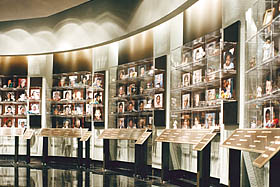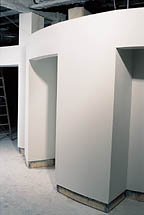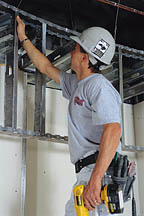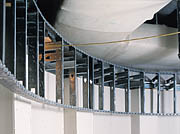

The museum is the final phase of the Oklahoma City National Memorial. The heavily symbolic and artistic outdoor memorial, with its 168 empty chairs representing the 168 people who died in the fateful blast, lies on the actual site of the razed Alfred P. Murrah Building, and was dedicated on April 19, 2000, five years to the day after the horrific event.
The museum is situated immediately east of the site, in the west end of the historic Journal Record Building, which was heavily damaged in the bombing.

From the heart
From the beginning of construction on the museum, the various crews appeared to be inspired to honor the victims and survivors by doing their very best work, cooperating with all the other participants, and finishing the job in time for the grand opening on Presidents Day, Feb. 19, 2001.Nick D’Aurizio, owner of D’Aurizio Drywall and Acoustics, of Oklahoma City, was no exception. His contract called for installing all the metal-stud framing and building all the walls and ceilings for the 30,000-square-foot, four-story museum. Some 15 to 20 percent of the linear feet of those walls and ceilings were specified to be curved.
Both D’Aurizio and his foreman, Larry Patterson, were very experienced with conventional methods of constructing curves in drywall. They expected each of the 500-square-foot fur-downs to take approximately eight hours for the crew to prepare, from the cutting of lengths of utility angle for shaping the curve, to the construction of a wooden template to support the shape.
But when D’Aurizio visited his local supplier, A & D Supply, to purchase materials for the project, owner George Hughes suggested that he consider using a relatively new, specialized product. Named Flex-C Trac, the product was designed and produced for the sole purpose of making curved drywall structures easier and quicker to produce, and stronger and more precise in final production.
Impressed by the concept, D’Aurizio spoke with the general contractor, Lippert Brothers Inc., who in turn sought approval of the product from the architect, C.H. Guernsey & Co. Although no one involved had seen Flex-C Trac before, it appeared to be a potential solution to achieve the precise formation of the various curves specified in the floor plan.
The total project required some 640 linear feet of Flex-C Trac. D’Aurizio says that the initial cost, while slightly higher than the conventional components of utility angle and plywood, was more than offset by the savings in time and labor. For example, each circular fur-down took a two-man team about two hours using Flex-C Trac—only one-fourth the time needed for traditional methods.
“There’s really no comparison,” says D’Aurizio, “and the result is a really smooth curve.”
“Labor-wise, it can’t be beat,” says Larry Patterson, foreman on the job. “And the structural integrity is far better than the old method of cutting and splicing track.”

Nice curves
D’Aurizio began the project in June 1999 and finished in January 2001. The use of the product relieved D’Aurizio and his team of much of the deadline stress that could have factored into the project.Flex-C Trac was designed and developed by Frank L. Wheeler, a former carpenter, who realized the need for a better, more efficient method for framing curves. The company he founded with four partners, Flexibility Concepts, currently manufactures Flex-C Trac, and has additional construction innovations in the works.
Construction companies in Canada, Australia and New Zealand, as well as across the United States, have used the product in commercial buildings. Now residential contractors are learning about and applying Flex-C Trac.
Available in widths of 21⁄2, 35⁄8 and 6 inches, all in lengths of 10 feet, the product is easily shaped by hand, on site, to fit any specified curve. The pivotal sections allow smooth arcs, with no flat spots.
Self-tapping screws, inserted through the holes in the side legs and into the flexible, sliding straps on either side of the track, secure the channel in the desired arc. Both the straps and the channel are manufactured of galvanized steel with an ASTM rating of #A653. The steel for the channel is 20-gauge.
In anchoring the track to the ceiling and/or floor, any standard stud—either wood or metal—will fit into the U-shaped channel, at any desired interval.
Finally, the frame is covered with drywall—as in the Oklahoma City National Memorial—or with whatever material the architect specifies. Flex-C Trac is designed to hold the exact curve rigidly, avoiding the flat spots that often characterized previous methods.
Although the museum project used the product for curvilinear walls and ceilings, it is equally suitable for constructing vaults, door-arches, columns, radius stairs and other curved applications.
The spirit of purpose and cooperation that pervaded the construction of the Oklahoma City National Memorial Center made it a unique assignment for everyone involved. That energy, combined with the use of a labor-saving product, contributed to contractor Nick D’Aurizio’s assessment that this was “one of the best construction experiences I’ve ever had.”


Report Abusive Comment